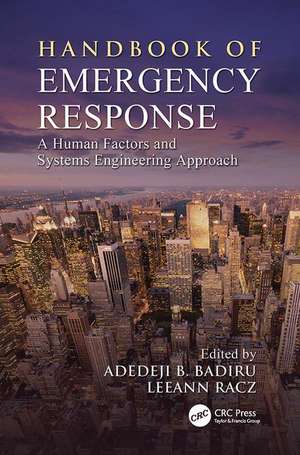Handbook of Emergency Response: A Human Factors and Systems Engineering Approach: Environmental and Occupational Health Series
Editat de Adedeji B. Badiru, LeeAnn Raczen Limba Engleză Paperback – 29 mar 2017
A useful tool to mitigate logistical problems that often follow disasters or extreme events, the core of this guide is the role of human factors in emergency response project management. The handbook provides a systematic structure for communication, cooperation, and coordination. It highlights what must be done and when, and how to identify the resources required for each effort. The book tackles cutting-edge research in topics such as evacuation planning, chemical agent sensor placement, and riverflow prediction. It offers strategies for establishing an effective training program for first responders and insightful advice in managing waste associated with disasters.
Managing a project in the wake of a tragedy is complicated and involves various emotional, sentimental, reactive, and chaotic responses. This is the time that a structured communication model is most needed. Having a guiding model for emergency response can help put things in proper focus. This book provides that model. It guides you through planning for and responding to various emergencies and in overcoming the challenges in these tasks.
| Toate formatele și edițiile | Preț | Express |
|---|---|---|
| Paperback (1) | 483.93 lei 6-8 săpt. | |
| CRC Press – 29 mar 2017 | 483.93 lei 6-8 săpt. | |
| Hardback (1) | 1024.74 lei 6-8 săpt. | |
| CRC Press – 22 aug 2013 | 1024.74 lei 6-8 săpt. |
Preț: 483.93 lei
Preț vechi: 569.33 lei
-15% Nou
Puncte Express: 726
Preț estimativ în valută:
92.60€ • 96.94$ • 76.62£
92.60€ • 96.94$ • 76.62£
Carte tipărită la comandă
Livrare economică 05-19 aprilie
Preluare comenzi: 021 569.72.76
Specificații
ISBN-13: 9781138077331
ISBN-10: 113807733X
Pagini: 758
Ilustrații: 5 Equations; 59 Tables, black and white; 143 Illustrations, black and white
Dimensiuni: 156 x 234 x 38 mm
Greutate: 1.09 kg
Ediția:1
Editura: CRC Press
Colecția CRC Press
Seria Environmental and Occupational Health Series
ISBN-10: 113807733X
Pagini: 758
Ilustrații: 5 Equations; 59 Tables, black and white; 143 Illustrations, black and white
Dimensiuni: 156 x 234 x 38 mm
Greutate: 1.09 kg
Ediția:1
Editura: CRC Press
Colecția CRC Press
Seria Environmental and Occupational Health Series
Recenzii
"… logical and quantitative approaches have great values in the emergency response practices. This book is a comprehensive collection of methods and technologies with such approaches. … I recommend this book … we can learn a lot about the systems approach."
—Tomoichi Sato
—Tomoichi Sato
Notă biografică
Badiru, Adedeji B.; Racz, LeeAnn
Cuprins
Introduction Section I: Technical challenges Chapter 1 Robotic technologies for first response: A review Chapter 2 A practical, simplified chemical agent sensor placement methodology Chapter 3 Harnessing disruptive technologies: Quick systems engineering for emergency response Chapter 4 An emerging framework for unmanned aircraft systems in the national airspace system: Opportunities and challenges for first responders and emergency management Chapter 5 Optimization in evacuation route planning Chapter 6 Evacuation planning, analysis, and management Chapter 7 Hierarchical optimization for helicopter mission for evacuation Chapter 9 Riverflow prediction for emergency response: Military applications using artificial neural networks Section II: Human factors issues Chapter 10 Understanding the influence of the “cry wolf hypothesis” and “false alarm effect” on public response to emergency warnings Chapter 11 Accessible emergency management: A human factors engineering approach Chapter 12 Framework for preparing for the unprepared Chapter 13 Lest we forget: A critical analysis of bioterrorist incidents, national exercises, and U.S. prevention, response, and recovery strategies Chapter 14 Resilience to WMD: Communication and active participation are key Chapter 15 First responders: A biomechanical evaluation of supply distribution Chapter 16 Dynamics and dangers of therapeutic strategies for organophosphate poisoning: A physiologically based model Section III: Managerial models Chapter 17 Coordinated project systems approach to emergency response Chapter 18 Overcoming obstacles to integrated response among incongruent organizations Chapter 19 Decisions in disaster recovery operations: A game theoretic perspective on organization cooperation Chapter 20 Integrating Department of Defense response with nongovernmental organizations during a disaster Chapter 21 Time is a murderer: The cost of critical path drag in emergency response Chapter 22 Coordination and control in emergency response Chapter 23 Managing the complexities of incident command Chapter 24 Begin with the end in mind: An all-hazards systems approach to waste management planning for homeland security incidents Chapter 25 Creating effective response communications Chapter 26 Assessing the state of knowledge about emergency management in other countries Chapter 27 Framework for real-time, all-hazards global situational awareness Chapter 28 All-hazards response team preparation: Planning and training concepts Chapter 29 Medical supply chain resiliency in disasters Chapter 30 Decision support for inland waterways emergency response
Descriere
Despite the best preparation, the risk of natural disasters, catastrophic accidents, and terrorist attacks cannot be completely eliminated. A carefully prepared response is the best defense. This handbook presents comprehensive guidelines for researchers and practitioners for a coordinated execution of emergency response. An essential tool to mitigate logistical problems that often follow disasters or extreme events, the book emphasizes human factors in emergency project management that involve a systematic structure for communication, cooperation, and coordination. The book highlights what must be done and when, and identifies the resources required for each effort.
















